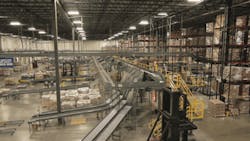As mega-retailers grow through new stores and outlets, with investments in e-commerce marketing and sales and through the acquisition of smaller competitors, many consumer packaged goods (CPG) suppliers face margin pressure in helping these customers evolve. They are working to strike a balance between customer support and logistics costs.
Beiersdorf, a $7 billion CPG manufacturer, has reconfigured its facility floor plan, installed a new material handling system, utilized state-of-the-art software and other technology and instituted process improvements to grow with their retailer customers. In doing so, this manufacturer of skin and beauty care products (such as Nivea, Eucerin and Aquaphor) is able to focus on customer service requirements while identifying new opportunities to reduce their own operating costs.
Managing this balance successfully has resulted in its recognition as “Supplier of the Year” by Walmart and “Partner of the Year” by Target.
One of the more recent retailer requirements Beiersdorf has been dealing with is reducing carrying costs and improving their ability to react to variability in marketplace demand. The lower the inventory level, the less likely products will become obsolete as consumers’ tastes evolve.
At the same time, retailer orders to CPG suppliers such as Beiersdorf have become much smaller and more frequent to enable rapid response to the market. Distribution center (DC) managers realize that smaller, more frequent orders can drive most of the metrics by which DC performance is managed in the wrong direction (i.e., higher handling cost per unit, higher distribution costs as a percent of sales, etc.).
To accomplish this, Beiersdorf worked with long-time consulting engineering partner, FORTE, to identify the following key goals:
- Upgrade and relocate the pallet stretch wrapper to increase queuing capacity for inbound and outbound pallets and to open up additional dock space;
- Expand the parcel consolidation area to efficiently handle the increase in small orders;
- Upgrade the reporting metrics and workload monitoring capabilities of its warehouse control system (utilizing FORTE’s Automation Director) and provide access of key metrics to employees as part of a continuous improvement process.
Displaying a New Service
Retail organizations are also working harder to differentiate themselves through creative marketing, including a strong emphasis on product displays to draw the shopper’s attention to a specific product line or supplier’s offerings.
Each retailer expects its suppliers to continually offer new, freshly-designed displays that are customized to its consumer base. DCs are challenged to build displays in increasing quantities and varieties and often find that subcontracting this work to a “co-packer” is more efficient than assembling the displays in-house.
However, the typical co-packer arrangement has historically involved:
- The DC shipping the products and display units to the co-packer.
- The co-packer assembling the displays and shipping them back to the DC.
- The DC receiving the displays and shipping them to the retailers as needed.
There are two obvious disadvantages to these types of contractual arrangements. First, the handling and administrative effort associated with the additional shipments is costly and increases the risk for product damage. Secondly, the overall cycle time — from recognizing the need, to display assembly, to the point of availability for shipment to the retailers — is much longer than if assembled in-house.
To avoid these unfavorable conditions, Beiersdorf developed a plan to bring the co-packer’s operations into Beiersdorf’s own distribution facility. This plan became a reality through the re-configuration of the reserve storage high-bay area, as well as other DC layout changes to free up space for the co-packer.
A wall was erected to allow the co-packer to operate without interference from routine Beiersdorf DC operations. A powered pallet conveyor system was engineered and installed to move bulk product to the co-packer’s operation and bring palletized completed displays back into the Beiersdorf inventory. To eliminate the manual administration of inventory ownership, the conveyor system was equipped with automated scanners that track inventory transactions in real time with each pallet’s movement between the two operations.
While accepting the challenge to help its retailer customers achieve their goals, Beiersdorf committed itself to deriving substantial internal benefits along the way. Beiersdorf and its co-packer have streamlined the entire display-build process, with internal cost savings and much improved cycle time for display availability. In fact Beiersdorf, its retail customers and its co-packer all benefit.
New Product Sizes and Weights
While retailers continuously strive to offer their customers an increasing array of products, the shelf space allocated for each product continues to shrink and their CPG suppliers are challenged to reduce case quantities. As case quantities shrink, CPG suppliers find that their pick modules and conveyor systems are no longer able to effectively handle some of the smaller, lighter cases developed with the retail shelf requirements in mind. The simple answer, followed by many suppliers, is to remove the “problem” products from the pick module and handle them manually.
Beiersdorf and FORTE developed a series of material handling system changes to accommodate the new case sizes and weights.
Best-in-class technology that has been developed since Beiersdorf’s original installation was leveraged to improve theConveyor improvements implemented to enable the delivery of smaller, lighter product cases include:
- The addition of photo-sensors to more effectively track positioning of cartons on the accumulation conveyor;
- The replacement of several sections of the gravity steel roller conveyor with a low-friction, skate-wheel conveyor, including after-sort lanes;
- The reduction of spacing between rollers at major conveyor transition points.
Through these improvements, Beiersdorf accommodated its retail customers’ needs and refused to allow the reduction in case quantities to push it toward increased manual picking and consolidation of product orders. In fact, picks and sorts through its automated material handling system have been unaffected.”
This project reinforced for Beiersdorf’s logistics team the belief that excellent customer service is priceless.
Randy Suer is director of logistics at Beiersdorf (www.beiersdorf.com) and Jeff Ross is vice president of consulting at FORTE.







